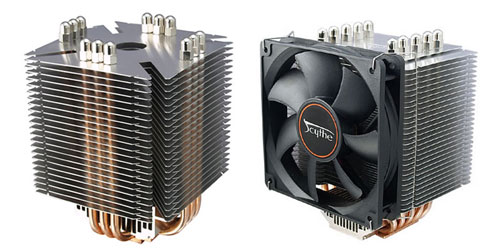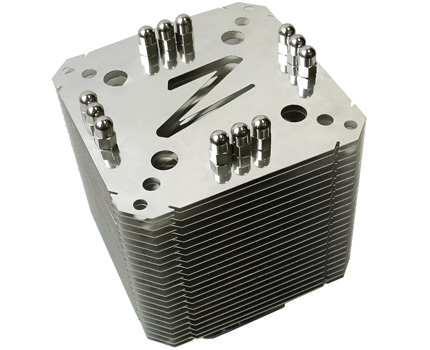Scythe Ninja Plus Rev. B: Updated Cooling Legend
by Wesley Fink on April 11, 2007 2:00 AM EST- Posted in
- Cases/Cooling/PSUs
In the past the Ninja name was used to designate the top-of-the-line Scythe coolers. Then somewhere along the development road the Infinity name rose to the top of the Scythe catalog. In the current Scythe lineup the two coolers are remarkably similar in features, but with slightly different design approaches to the cooling task.

While both the Ninja and Infinity use 6 heatpipes for cooling in a tower arrangement, the Infinity is wider than it is thick and groups the heatpipes on the two sides of the fin array. The Ninja, on the other hand, is square with three in-line heatpipes on each side of the square. One purpose of this review is to determine which of these design approaches is the most effective in cooling.

It was also pointed out in our recent review of the OCZ Vindicator that the Vindicator looked like a relabeled Ninja Plus Rev. B. Looks, however, can be very deceiving and benchmarking the Ninja Plus B should provide better answers to the question of how similar the OCZ Vindicator and Ninja Plus B actually are. If the Ninja Plus B performs much better or much worse than the Vindicator tested with the same fan, then it is reasonable to assume the designs are really different. If performance is virtually the same, then it is reasonable to conclude that these are likely the same base cooler.
There is no getting around the fact that the Scythe Ninja Plus B is a big cooler. Most of the heatpipe towers are huge, which is part of why they are effective. The good news is the fin array is raised enough that it clears the power transistor passive coolers, heatpipes, caps, and fans on every board we had in the lab. This even includes fitting on the ASUS Striker and Commando boards, which can be a challenge with their raised heatpipes and passive cooling sinks surrounding the CPU socket. There's not any room left on these ASUS boards to fit hands between the heatpipe ring of the board and the fin array of the Ninja Plus B, but you can mount and unmount the Ninja Plus B if you are careful and first remove the motherboard from the case.

While both the Ninja and Infinity use 6 heatpipes for cooling in a tower arrangement, the Infinity is wider than it is thick and groups the heatpipes on the two sides of the fin array. The Ninja, on the other hand, is square with three in-line heatpipes on each side of the square. One purpose of this review is to determine which of these design approaches is the most effective in cooling.

It was also pointed out in our recent review of the OCZ Vindicator that the Vindicator looked like a relabeled Ninja Plus Rev. B. Looks, however, can be very deceiving and benchmarking the Ninja Plus B should provide better answers to the question of how similar the OCZ Vindicator and Ninja Plus B actually are. If the Ninja Plus B performs much better or much worse than the Vindicator tested with the same fan, then it is reasonable to assume the designs are really different. If performance is virtually the same, then it is reasonable to conclude that these are likely the same base cooler.
There is no getting around the fact that the Scythe Ninja Plus B is a big cooler. Most of the heatpipe towers are huge, which is part of why they are effective. The good news is the fin array is raised enough that it clears the power transistor passive coolers, heatpipes, caps, and fans on every board we had in the lab. This even includes fitting on the ASUS Striker and Commando boards, which can be a challenge with their raised heatpipes and passive cooling sinks surrounding the CPU socket. There's not any room left on these ASUS boards to fit hands between the heatpipe ring of the board and the fin array of the Ninja Plus B, but you can mount and unmount the Ninja Plus B if you are careful and first remove the motherboard from the case.










36 Comments
View All Comments
Pirks - Wednesday, April 11, 2007 - link
I'm going to get myself a monster of a heatsink called Cooler Master GeminII. It has two 120mm fans on top that blow right down on the mobo. On the other hand I keep reading all these news here coming from Gary, Wesley, Jarred and the gang, that tower coolers like Infinity or Thermalright kick ass and yield only to waterblocks. Now, the question is - are you guys really missing this important part of cooling mosfets, power circuitry, some northbridge, memory etc? Or is it really unimportant?I mean, what's the point in having such an imbalanced cooling solution where the CPU is cool but evetything else is almost melting? I recall my experience with Athlon XP in a tight poorly ventilated case - I put Zalman on it instead of a little tower HSF and you you know what? The power circuitry temperature went down 16 degrees right there, and I stopped getting Windows freezing on me. Stability became just like on those pesky Macs (j/k) :)
So what is it? A vertical tower? Or a horizontal cooler that blows on mosfets? Or a mix of both with tower and additional coolers around it to cool mosfets?
At least a link to some systematic research won't hurt, I can only see opinionated forums where half of the population says towers suck because they don't cool mosfets and the other half says towers rock precisely because they don't cool mosfets :) Wesley? Gary? Any other AT overclocking guru? What's your opinion and arguments for it (or against it)?
LaGUNaMAN - Thursday, April 12, 2007 - link
Speaking of the Cooler Master GeminII, requesting to have that reviewed as well. Great job on the article BTW Bozz Wesley. Can't wait for the 120mm fan roundup. (^^,)Wesley Fink - Friday, April 13, 2007 - link
The CoolerMaster Gemini II is in the lab for review. I agree it looks really promising with a pair of low-noise high-output fans. We hope to get to it within the next couple of weeks.Kaleid - Saturday, April 14, 2007 - link
Could you try placing one fan in the middle of that cooler? Does it really perform better with two fans or would one silent fan do the trick?Stele - Wednesday, April 11, 2007 - link
That's a very good question, one which I've often asked myself when looking for coolers. Granted, a straight-through airflow right out the back of the casing helps prevent a build-up of warm air inside it, but that would leave a weak level of airflow around the other hotspots on the motherboard... especially with the likes of a 680i SLI overclocked.
It would be terrific if Anandtech could deploy a few thermocouple probes or even an IR thermometer and measure the temperatures of those hotspots - PWM heatsink (or PWM MOSFET if no heatsink present), northbridge, and if time allows, perhaps even the side of a RAM DIMM and graphics card nearest the CPU socket area. That would certainly help differentiate the coolers good at just cooling the CPU from those that can do better overall. :)
noobzter - Wednesday, April 11, 2007 - link
1. How does the CPU temp as reported in NTune compare to TAT's?2. What was the ambient temp during the test?
noobzter - Thursday, April 12, 2007 - link
Sweet, thanks!Wesley Fink - Thursday, April 12, 2007 - link
TAT workload testing with the stock Scythe fan on the Ninja Plus B show test results virtually the same at TAT 80% CPU load as our 30 minute gaming tests. Since you are likely familiar with TAT results that info may be useful. TAT does stress both cores in testing, which our current game tests do not do.Wesley Fink - Thursday, April 12, 2007 - link
1. TAT (Thermal Analysis Tool) is an Intel program, so it did not occur to us to use it for verification on an nVidia chipset. However, it is CPU centric, and we found it DOES work on the 680i chipset. Comparing Idle temps to nVidia Monitor results at 3.73GHz overclocked showed reported Monitor and TAT temps within 0-2C of each other. We will test more with TAT using internal load tests in the future.2. Ambient room temperature during tests is 70F (21C).
iluvdeal - Wednesday, April 11, 2007 - link
I am looking for a quiet HSF which allows good OCing for a Core2Duo and the Ninja fits that bill, however the one thing that's constantly repeated about it is it's difficult to securely mount with a S775. That's what scared me away from it.